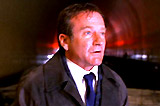
|
Deaths Scenes 1998 |


|
Saving Private Ryan (1998) Director Steven Spielberg's WWII-era film documented the bloody beach assault at Normandy (in June of 1944) in its first 30 minutes. However, a few other death scenes were just as notable. In another intense combat scene set on the second story of a heavily-damaged building, an unnamed Waffen-SS German soldier engaged in a lengthy hand-to-hand struggle with tough Brooklyn Jew - Pvt. Stanley Mellish (Adam Goldberg). The German slowly gained the upper hand when exhaustion set in. A drawn bayonet knife was turned around and pointed toward Mellish's own chest, as the American begged: "Listen to me, listen to me, Stop! Stop!" The German slowly pushed the knife into Mellish's chest, whispering something to him about being quiet and giving up since it would be over soon. Mellish's body shook slightly as his life left him.
Wounded and unable to move on the stairs only a few feet away, Timothy Upham (Jeremy Davies) had failed to defend Mellish. |
  |
||||||||||

|
Saving Private Ryan (1998) Commanding officer Captain John Miller (Tom Hanks) poignantly sacrificed his life, when critically wounded by heavy German fire while trying to defend Ramelle's bridge against an expected German attack. Captain Miller was knocked to the ground by the blast of a German tank shell. A detonation device for explosives had been knocked out of his hands, and as he moved across the bridge to retrieve it, Miller was fatally shot in the chest. The shot had been fired by "Steamboat Willie," the same German soldier that Miller had set free earlier. As he died, he leaned himself against a motorcycle as a tank approached his position. He made a last stand by firing at the tank as it got closer, until P-51 tankbuster bomber support arrived. A medic was called to treat Miller. His final heroic, weakly-muttered words were an order to PFC James Ryan (Matt Damon) to 'earn' the sacrifices that saved him on the mission, before his eyes flickered and he ceased living:
In voice-over, a lengthy letter from General Chief of Staff George C. Marshall to Ryan's mother was read. It informed her that her sole surviving, youngest son was alive and returning home from the European battlefield:
As the lengthy letter from General Marshall was read to Ryan's mother, Ryan's face transitionally dissolved or morphed into the face of the nameless, elderly teary-eyed veteran (Harrison Young) - revealed to be an older Ryan - visiting the Normandy cemetery at the film's beginning (50 years later) - at the grave site of Captain Miller. The older, teary-eyed Ryan asked his wife for reassurance: ("Am I a good man? Tell me that I have been a good man"), and uncomprehendingly - she reassured him
The final image was of a back-lit American flag billowing in the wind. |
|
||||||||||

|
The Thin Red Line (1998) Reclusive director Terrence Malick's third feature film in 25 years was this acclaimed philosophical war film with lush cinematography, portraying soldiers during WWII. During patrol on the island of Guadalcanal, introspective U.S. Army Private Robert Witt (James Caviezel) was shot to death after a selfless, sacrificial action. He had successfully acted as a decoy to lure the Japanese away from his two companions (Corporal Geoffrey Fife (Adrien Brody) and Private Coombs (Matt Doran)) and the rest of their unit, but found himself surrounded in a clearing by enemy soldiers. As the Japanese moved in, he stood and surveyed how he was doomed. Against impossible odds, he raised his rifle and was instantly killed. He contemplatively mused to himself in voice-over, about calmly facing his own fateful death like his mother had done:
After his death, the film cut to an upward-looking shot of plants and trees in the jungle (with sunlight filtering through) and then to Witt swimming in the ocean with native boys.
Later, his body was buried in a shallow grave with his rifle and helmet as a marker. |
    
|
||||||||||

|
Urban Legend (1998) Director Jamie Blanks' horror-slasher film's many death set-pieces were committed by an unknown "urban legend" serial killer. The setting of the film was on the Maine campus of fictional Pendleton University. The campus was notorious for an event that happened almost 25 years earlier in 1973 - a horrific legendary (or covered-up?) mass murder in Stanley Hall, with only one survivor. Six students with slit throats from a hunting knife were allegedly killed by a beserk Abnormal Psychology professor who then committed suicide by stabbing himself through the heart. Nine killings in total comprised the film - the killer used "urban legend" tales as the MO for each of the killings. THE FIRST VICTIM: In the film's opening scene, current 20 year-old Pendleton University student Michelle Mancini (Natasha Gregson Wagner) was decapitated with an axe wielded by someone in the back seat of her car. She might have avoided dying, but she nervously fled before heeding the helpful warning of creepy, stuttering gas-station attendant Michael McDonald (Brad Dourif):
THE THIRD VICTIM: Tosh Guaneri (Danielle Harris), an angry, manic-depressive goth student, died and might have been saved, when her red-haired roommate Natalie Simon (Alicia Witt) came into their darkened dorm-room - and didn't turn on the light. Natalie thought Tosh was just having noisy sex one more time, although she was being strangled and her wrists slashed. Her blood was used to scrawl on the wall: "Aren't You Glad You Didn't Turn On the Light?" THE FOURTH VICTIM: The school's Dean Adams (John Neville) was impaled on parking garage spikes after his Achilles heels were slashed. THE EIGHTH VICTIM: 19 year-old college student Sasha Thomas (Tara Reid), the school's WZAB radio station sex-obsessed broadcaster, suffered a suspenseful death. At one point, she precariously hung onto a balcony edge as the killer whacked at her fingertips with an axe before she was brutally axed to death in the head. Smart, red-haired coed Natalie Simon (Alicia Witt) was a high-school friend of Michelle's (the first victim) - they had been team captains of their cheerleading squad. Natalie and her friends had recently learned about the phenomenon of urban legends in a class on folklore taught by expert Professor Wexler (Robert Englund) (who was later considered a major suspect since he was the sole 1973 survivor). The key to the motivation of the murderer was that Natalie had a hidden secret - she and past friend/victim Michelle had reenacted a modified version of an urban legend (the "Gang High-Beam Initiation" - driving with headlights off and lethally targeting the first driver who flashed their lights). They caused the senseless and tragic death of another motorist who lost control - although the two only received probation for "reckless endangerment." As it turned out in the big reveal, the dead motorist (David Evans) was the boyfriend ("the love of my life") of vengeful and deranged curly-haired student Brenda Bates (Rebecca Gayheart) - the film's revealed killer. Brenda was seeking revenge and blaming Natalie Simon and her friends for the accidental death, a year earlier, of her husband-to-be David Evans. After a number of killings, Brenda had assembled many of the dead corpses on the top floor of dilapidated Stanley Hall, where she had lit candles, and told a captured Natalie: "Gotcha!" She threatened: "Don't you want to be an urban legend? All your friends are now." Brenda's plan was to kill Natalie, and acquire her friend Paul as her new boyfriend. After failing to perform a deadly "Kidney Heist" operation on Natalie, Foxy Brown-wannabe campus guard Reese Wilson (Loretta Devine) rescued Natalie. But Brenda counter-attacked Reese with a knife and wrestled her gun away. Brenda was shot twice by both Reese and Natalie, and then crashed backwards through the third floor window. She reappeared wielding an axe in the backseat of Paul's vehicle, and was propelled into a river through the windshield when it crashed on a bridge - but the film's brief epilogue showed her still alive! Brenda was in a group of students in another school, embellishing the "urban legend" story just seen. She proposed to tell them exactly what had happened in the film's final line: "I believe you... but you didn't tell it right...Not at all. OK, listen up, guys, 'cause this is how the story really goes." The entire film (and its events) became an urban legend of its own ("This'll become a legend too, you know"). |
|
||||||||||

|
Waking Ned Devine (1998, UK/Ire.) Set in Ireland, this British comedy film told of the circumstances surrounding the death of Ned Devine (Jimmy Keogh), when he shockingly learned that his ticket was the winner of the Irish National Lottery's Lotto game. Efforts commenced by the townsfolk to fool the claims inspector (by pretending that Ned was still alive), and split the prize money among the town's inhabitants. Uncooperative, wheelchair-bound, witchy spinster Lizzy Quinn (Eileen Dromey) suffered an untimely demise while she was in a cliff-side phone booth. She was calling to inform lottery officials and expose the fraud that was being perpetrated, and to claim 10% of the prize (about 680,000 pounds). The booth was struck by the parish priest's van-truck, avoiding the lotto representative's swerving car when he sneezed. The booth sailed into the air and crashed far below on the cliff's shore. At the same time, all of the Tullymore townsfolk were celebrating their fraudulent winnings (130,000 pounds each) and a violin string broke during a high note. |
  Phone Booth Sailing Into Air and Crashing |
||||||||||

|
What Dreams May Come (1998) This supernatural fantasy drama-romance (with a Best Visual Effects Oscar) began with a horrific death in a car crash accident - the second car-related tragedy for the same family. Middle-aged pediatrician Dr. Christian "Chris" Nielsen (Robin Williams) died at the scene of a multi-car wreck in a tunnel. He had safely stopped his own vehicle, and rushed ahead on foot to find cars ahead of him turned upside down. When he was asking questions of a survivor needing help, he was smashed into by a white automobile catapulting toward him, before the screen turned black.
The next shot was "the mythical light" at the end of the tunnel, and then a top-shot as the doctor's body was placed on a stretcher by ambulance paramedics. A voice asked: "Chris, do you know what's happened?" He replied, jokingly: "Yeah, I had a bad piece of fish before bed." The screen turned to a blinding white light - as he lingered on Earth in a hospital bed. Although Chris didn't want to accept it and thought he was dreaming, he had died and couldn't be seen by his family members, relatives, and friends at his home, who were mourning his passing. His spiritual guide (Cuba Gooding, Jr.) told him: "You've died, Chris." As the story unfolded, the dead victim risked taking a journey from Heaven to Hell in the afterlife to rescue his beautiful wife Annie's (Annabella Sciorra) soul, after she committed suicide due to overwhelming grief and devastation. Very imaginative vistas and scenarios in Heaven and imprisoning dark Hell were presented. |
    The Fatal Car Crash |
||||||||||
(chronological by film title) Intro | 1915-1929 | 1930-1933 | 1934-1938 | 1939 | 1940-1942 | 1943-1945 | 1946-1947 | 1948-1949 1950-1952 | 1953-1955 | 1956-1957 | 1958-1959 1960-1961 | 1962-1963 | 1964-1966 | 1967-1968 | 1969-1970 1971 | 1972 | 1973 | 1974 | 1975 | 1976 | 1977-1978 | 1979 1980 | 1981 | 1982 | 1983 | 1984 | 1985 | 1986 | 1987 | 1987 | 1988 | 1989 1990 | 1991 | 1992 | 1993 | 1994 | 1994 | 1995 | 1995 | 1996 | 1997 | 1998 | 1998 | 1999 2000-2001 | 2002 | 2003 | 2004 | 2005 | 2006 | 2007 | 2008 | 2009 | 2010 | 2011 |